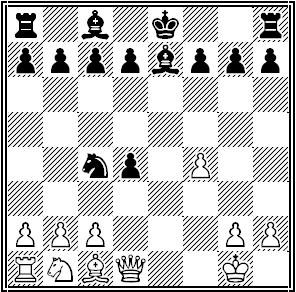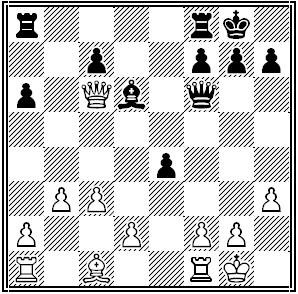Games of Note
Nothing too exciting going on. I actually have no excuse for not posting in a week.... I am currently unemployed (the good "unemployed" too.... the interim period between leaving one job and starting another). I have been squeezing lots of chess games in this "off period." Here's a couple of interesting games.
I have always thought the secret to being a great chess player only requires one to see two or three moves in the future.... all the time! The key is being able to consistently see those two or three moves. It's nice if you can usually or sometimes see two or three moves in advance, but what separates the good players from the bad players is the ability to consistently do so.
Here is a game I played the other day. It kind of shows this principle in action. White (me) has a pretty basic winning move in front of him. Do you see it? 1... Bh2!+ wins the queen with 2. Kxh2 Qxc5. I am definitely not picking on NN (I never name players who I beat in games -- call it class), but this was a pretty drastic error. And again without revealing NN's identity, what adds to the story is that NN is a fairly high ranked player on www.redhotpawn.com (not GM level, but rated in the top half of all players). I bet if NN looked at this position in a puzzle book he or she would be able to nail it in seconds -- again, though the key is to be able to consistently see such moves. While NN could probably see this problem 95% of the time, this was part of the 5% that he missed, and it cost him or her the game. (I definitely could see myself missing something like this).

Another amazing ability that separates good chess players from bad ones is the ability to "think outside of the box." Here's another good example.
Unknowingly, black has fallen into a common trap of the Italian Game opening. His e5 knight is being pinned by the e1 rook (i.e., he can't move his knight). With white's turn the inevitable 2. f4 will come with (the again inevitable) 2. fxe5 to follow (again, black's knight can't move to save itself from being captured by the pawn). And black will be down a piece.
Most players who see this position shrug their shoulders, grit their teeth and prepare for the loss playing something like 1... Bd6 or 1... d6 to protect the doomed knight (the thinking being at least "I'll take one or two of white's pawns in exchange for the lost knight").
 Geniuses can see beyond the boundaries of most people. 1... Qe7 saves the game for black. But won't the knight still be lost? No! Actually, after 2. f4 the correct move is 2... Nxc4. Okay, but now the queen is lost, right? Right. 3. Rxe7 indeed loses black's queen. But this is followed by 3... Be7 leaving this position (see right).
Geniuses can see beyond the boundaries of most people. 1... Qe7 saves the game for black. But won't the knight still be lost? No! Actually, after 2. f4 the correct move is 2... Nxc4. Okay, but now the queen is lost, right? Right. 3. Rxe7 indeed loses black's queen. But this is followed by 3... Be7 leaving this position (see right).While black's queen is gone, it came at the price of a bishop and rook for white. While white clearly has an advantage (1.09 according to Chessmaster 9000), it is much more subtle than the early loss of the black knight.
In the actual game, black didn't see this excellent move. Again, I am not picking on anyone. I clearly would have missed it too.



2 Comments:
The first diagram is a nice easy one. However, shouldn't it say black to move and win? :-)
JDK
JDK2, you are absolutely right. I'll make the change.
Post a Comment
<< BACK TO THE REST OF THE SITE!